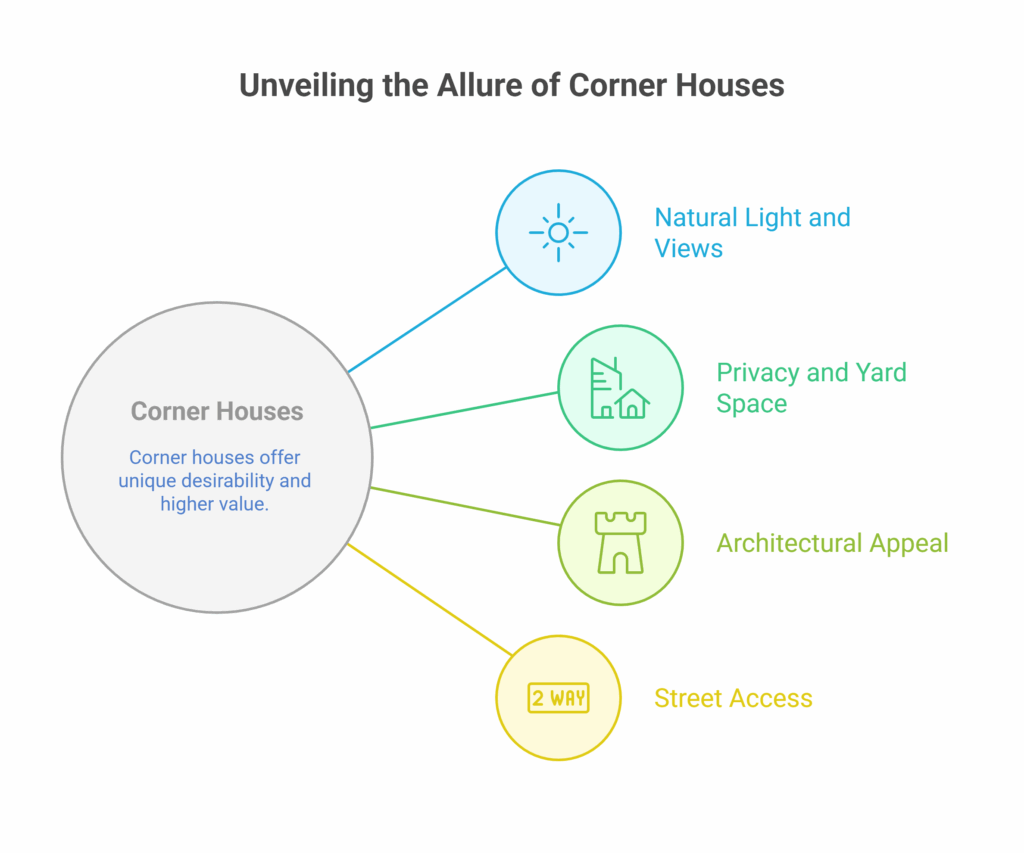Quick Answer: Why Are Corner Houses More Expensive?
“Why Are Corner Houses More Expensive?” is a question many homebuyers ask, and the answer comes down to space, visibility, and appeal. Corner houses usually sit on larger plots, offering more yard space, natural light, and design flexibility. They also have two street frontages, which increases curb appeal and makes the property look more prominent. In many neighborhoods, this added visibility means higher demand and, naturally, higher prices. On the flip side, corner homes may face more traffic noise and less privacy, but their advantages often outweigh these drawbacks in the eyes of buyers.
Simply put, when you wonder, “Why Are Corner Houses More Expensive?”—it’s because they offer more of what many buyers value most: space, exposure, and uniqueness.
Now let’s dive deeper.

1. More Land, More Value
One of the most obvious reasons corner homes are more expensive is the extra land. Unlike interior lots that are flanked by houses on both sides, corner properties typically enjoy more yard space — both in the front and on the side. This additional land increases the property’s square footage, which naturally raises its market value.
For homeowners, this means more room for outdoor living areas, pools, landscaping, or future home expansions. For investors or developers, it opens up greater possibilities for improvements and resale potential.
2. Increased Curb Appeal
A corner house has more exterior walls facing the street, which gives it increased visibility. This visibility can translate to enhanced curb appeal. With two visible sides, homeowners can showcase landscaping, decorative architecture, or unique designs, which might not be as noticeable on an interior lot.
A home that looks better from the street tends to attract more buyers, making it a hot commodity in competitive markets. It also means that a well-maintained corner home can fetch a premium price simply because it looks more appealing.
3. Greater Privacy and Fewer Shared Walls
Corner homes often provide a greater sense of space and separation from neighbors. Since there’s typically only one neighboring house directly adjacent, residents get more privacy compared to homes sandwiched between two others.
This can be particularly attractive for families or individuals who value quiet living. Plus, fewer shared walls and less foot traffic nearby can mean fewer disturbances — something that many house hunters are willing to pay extra for.
4. Better Natural Light and Ventilation
With more exterior walls and windows, corner houses usually enjoy better airflow and more natural light. This can make the home feel brighter, more open, and more inviting.
From an energy-efficiency standpoint, increased ventilation can also reduce the need for artificial cooling in warmer months — something especially important in warmer states like Texas.
5. Easier Access and Parking
Another functional benefit of corner houses is easier access. Because they sit at the junction of two streets, entering and exiting the property becomes more flexible. Additionally, these homes often have more curb space, which means more room for guest parking — a rare and valuable feature in crowded neighborhoods.
Some corner lots may even allow for driveways on both streets or rear-lot access, making them attractive to homeowners with multiple vehicles, trailers, or RVs.
6. Ideal for Custom Builds and Enhancements
From a design perspective, corner lots provide a blank canvas for creativity. Homebuilders love them because they allow for more flexible floorplans, interesting angles, and unique architectural styles.
If you’re considering a remodel or expansion in the future, a corner lot often offers more options without the tight constraints found on interior lots.
7. Perceived Prestige and Status
Let’s face it: sometimes it’s all about perception. A corner house, with its expansive yard, striking façade, and strategic location, can give off a sense of prestige. People often associate corner properties with prominence or importance, especially if they are larger or more ornate.
For some homebuyers, owning the “best-looking house on the block” is worth paying a bit extra.
Considerations: Not All That Glitters…
While corner houses have plenty of advantages, there are a few downsides buyers should weigh:
- More maintenance: More yard means more upkeep — lawn care, fencing, and landscaping can take extra time and money.
- Noise and traffic: Being near an intersection may expose the home to more car and foot traffic.
- Security: With more windows and street access, some corner homes may be more vulnerable to break-ins if not properly secured.
Still, for many buyers, the benefits outweigh the challenges — especially in areas where land is scarce and visibility is valued.
Final Thoughts
Corner houses are often priced higher because they offer more land, better aesthetics, increased privacy, and greater design flexibility. While they may come with a few added responsibilities, their perks are enough to attract attention and demand top dollar in most markets.
If you’re in the market to buy or sell a property in Texas, it’s crucial to understand how lot positioning can influence property value. Whether you’re eyeing a charming corner house or a cozy interior lot, make sure you work with a trusted local expert who understands the nuances of the Texas real estate market.
Looking to buy or sell a property in Texas? Connect with our experienced team of trusted professionals today. We work with serious house buyers Texas who can help you make the most of your real estate goals.
Call us anytime at 713-561-5162 or connect with us on our website and we’ll lay out all of your options for your specific situation.
